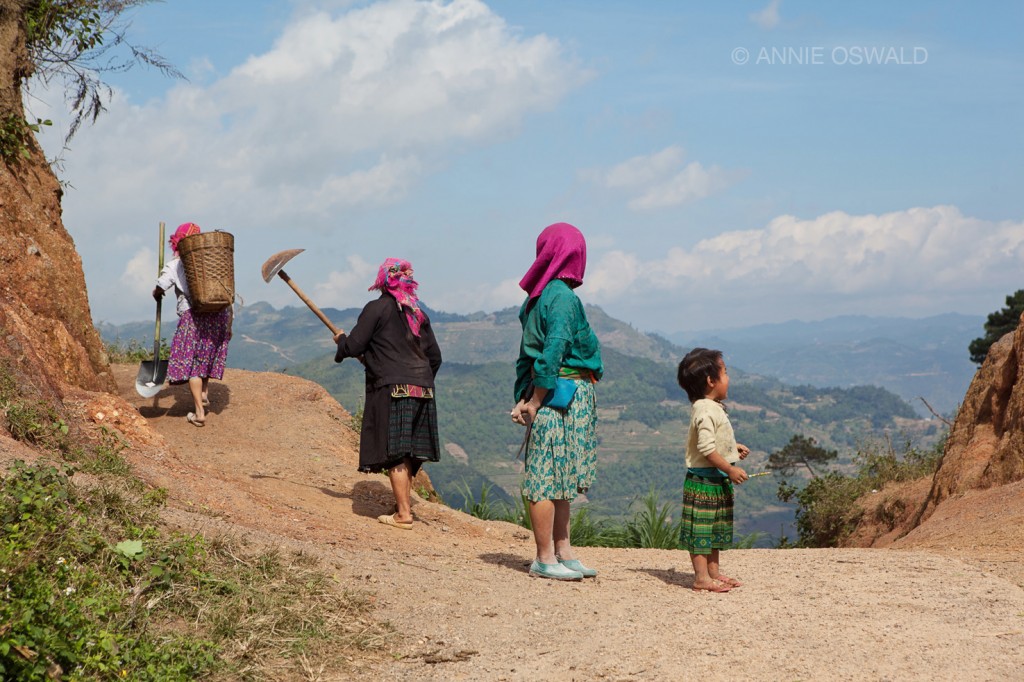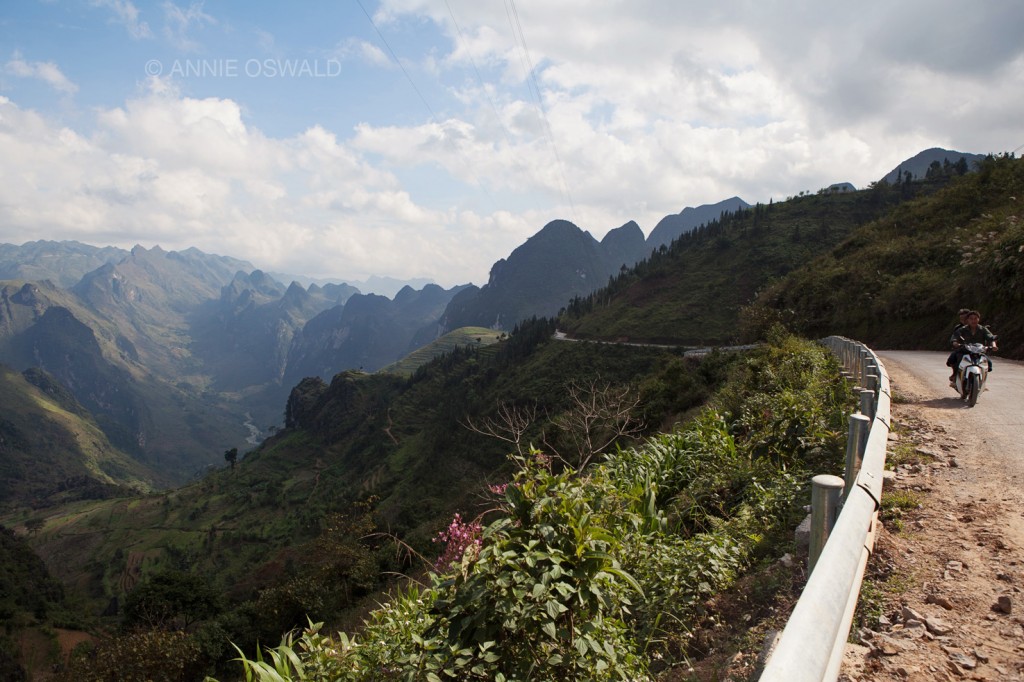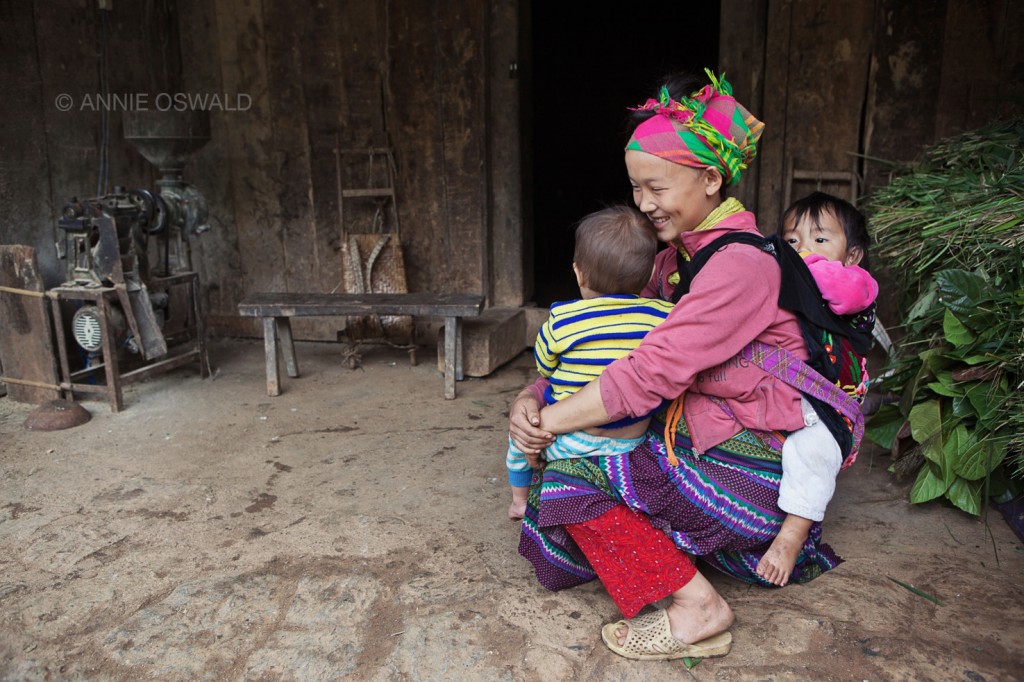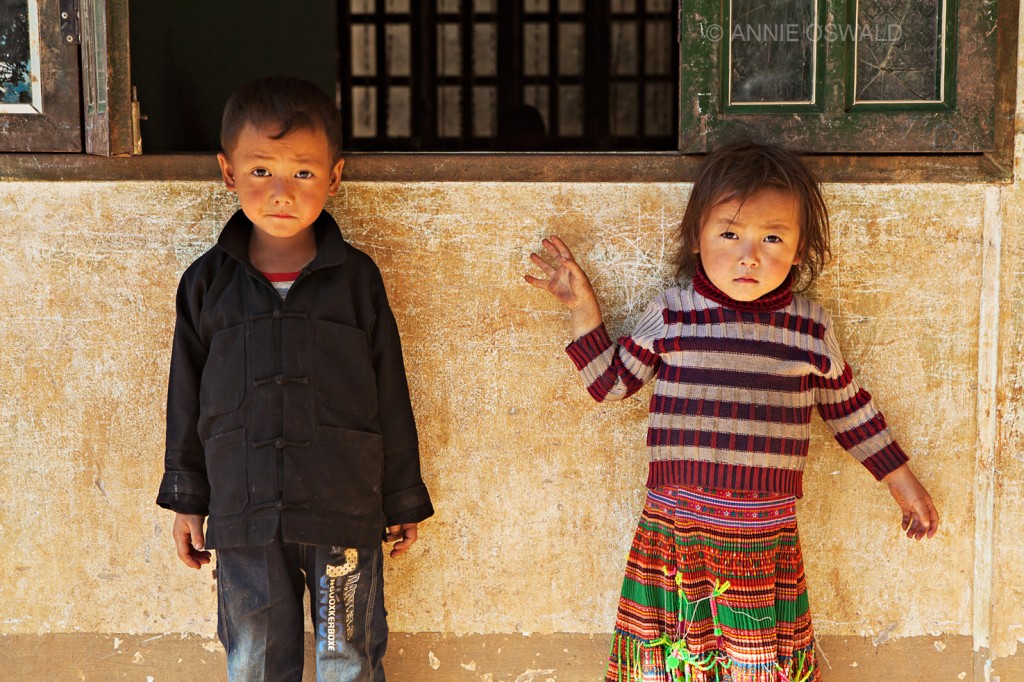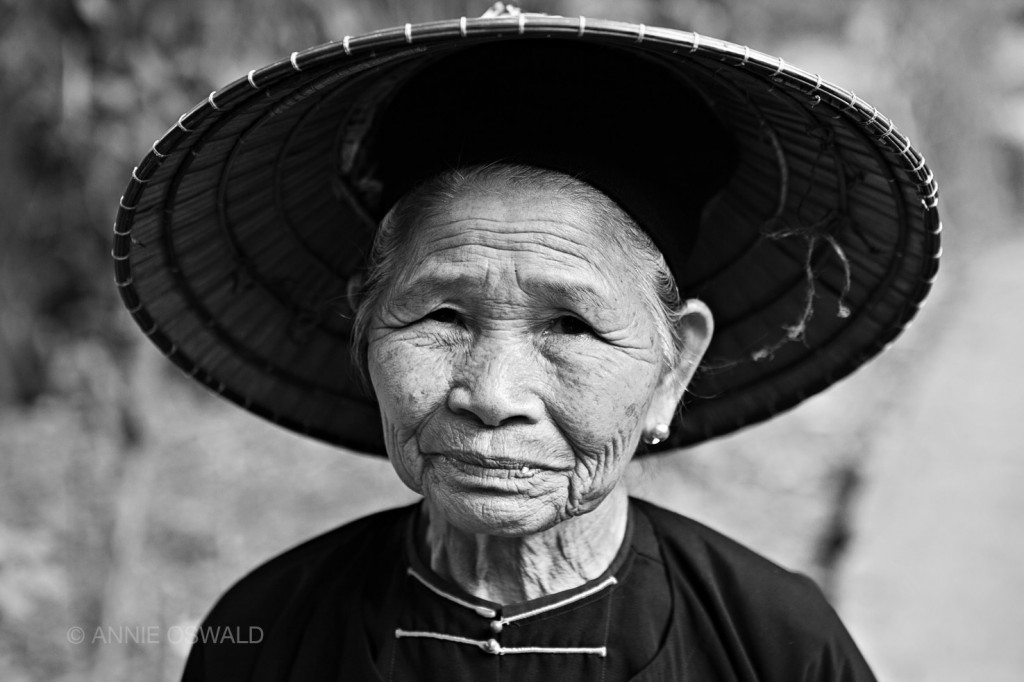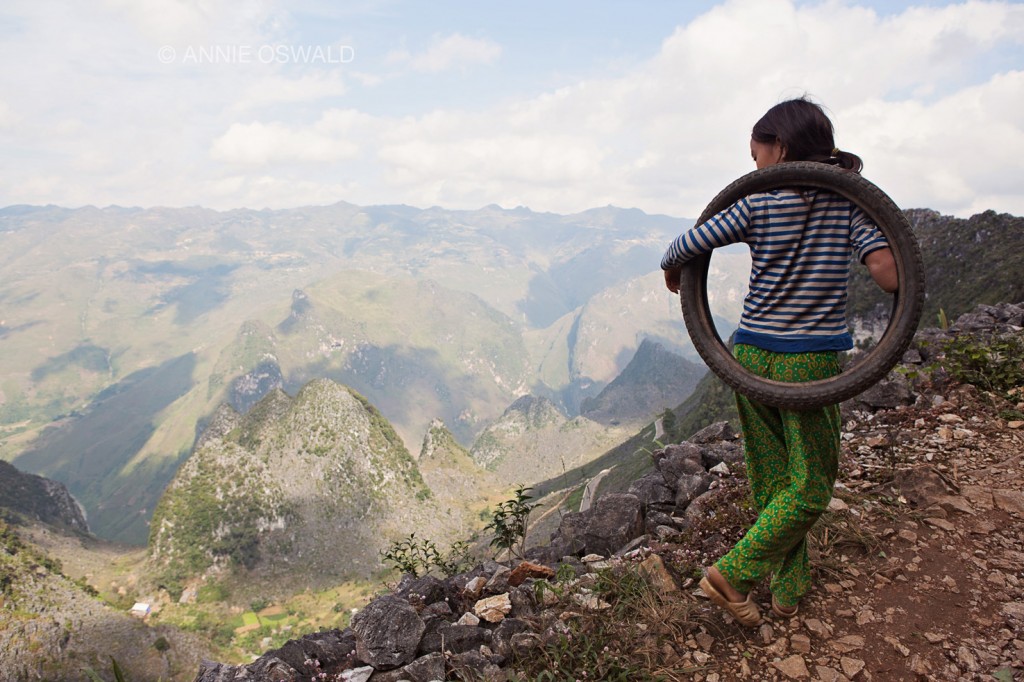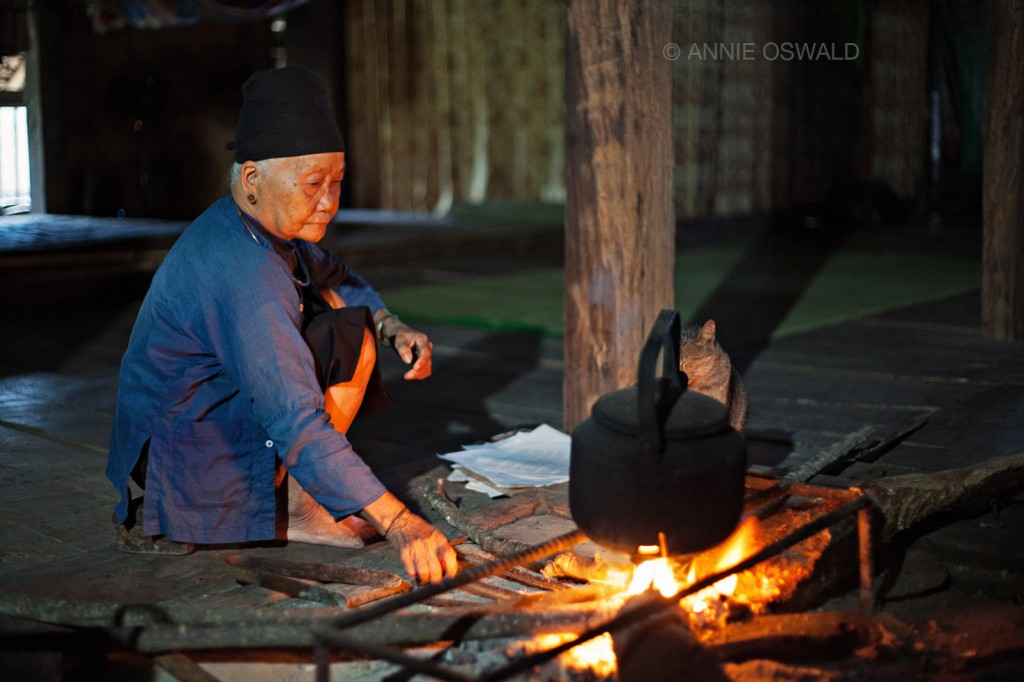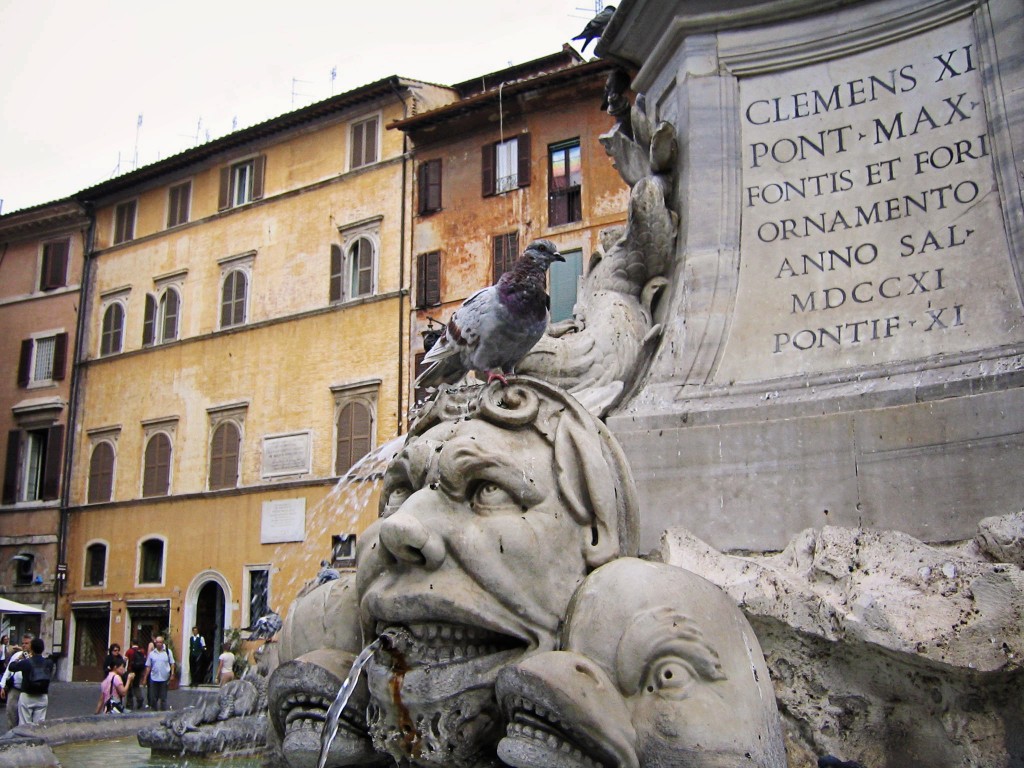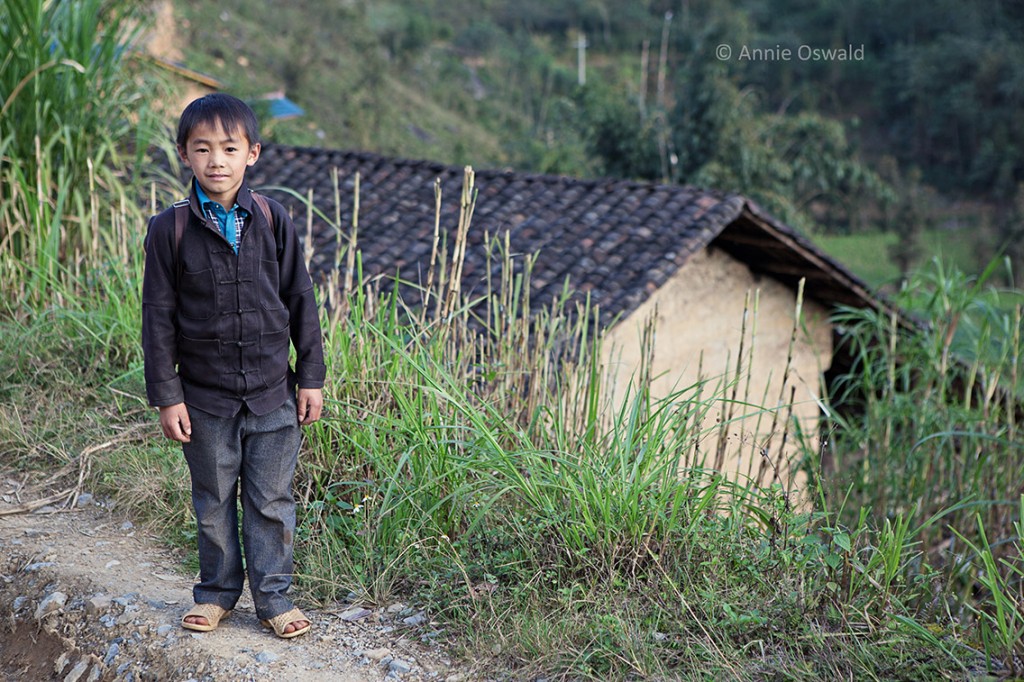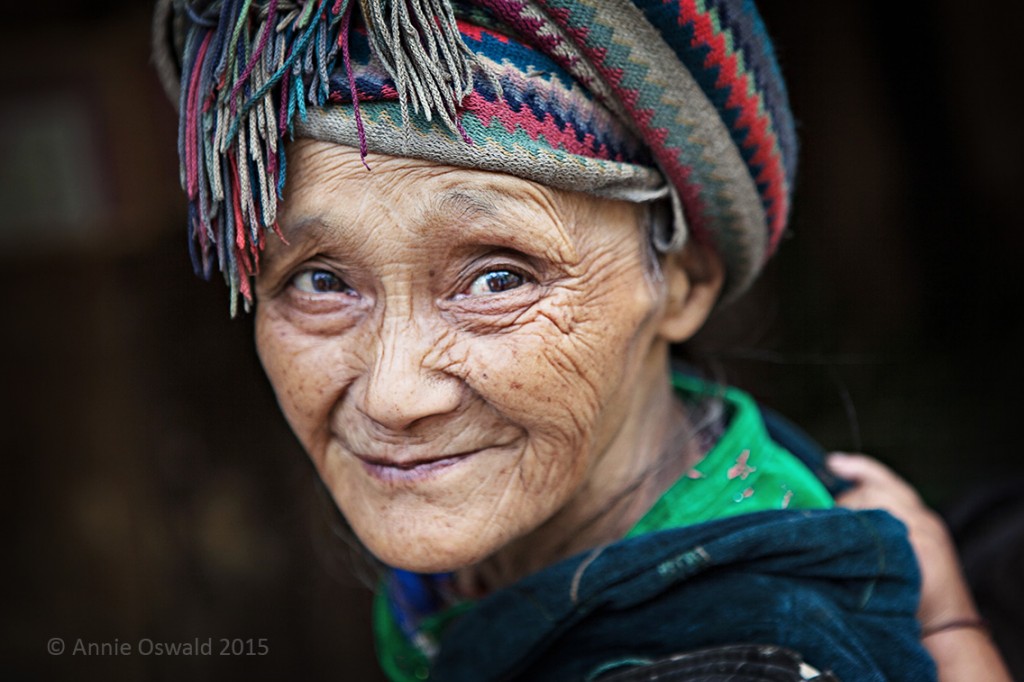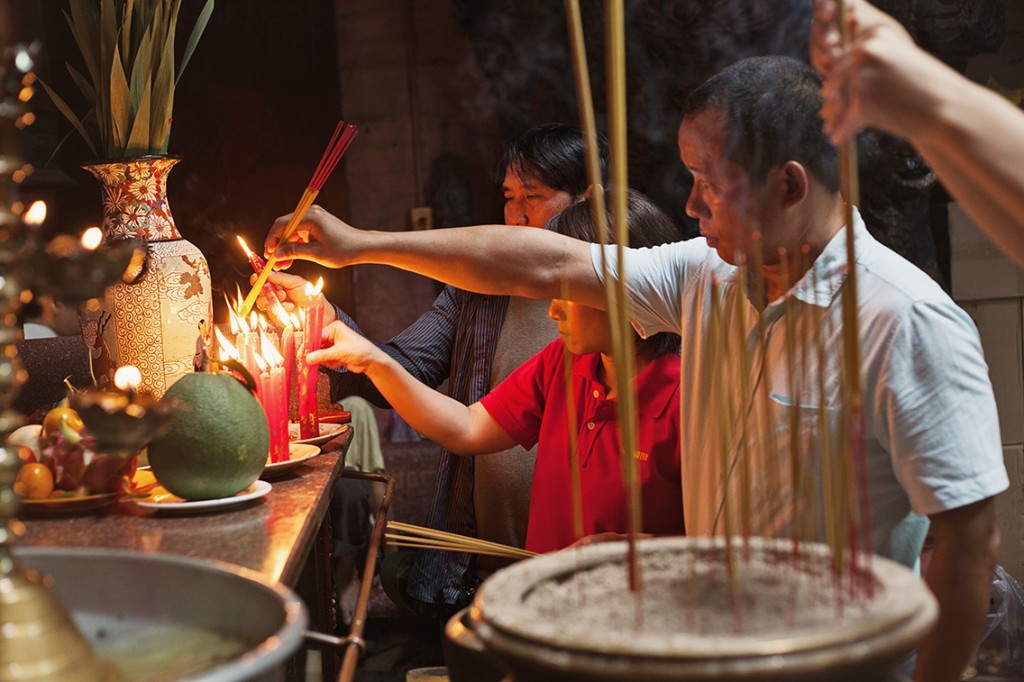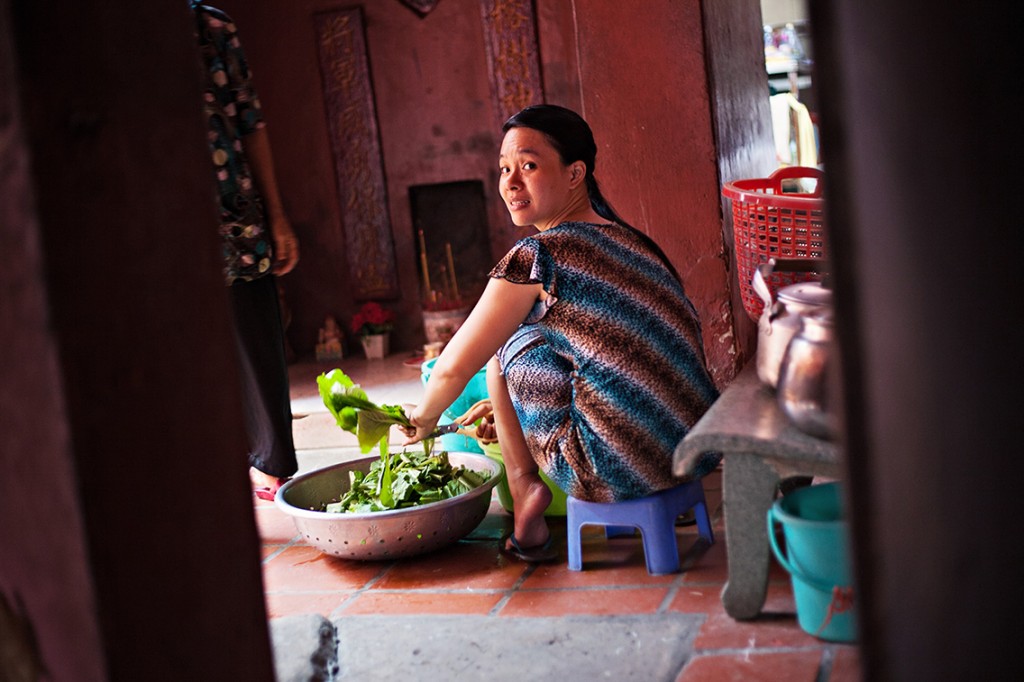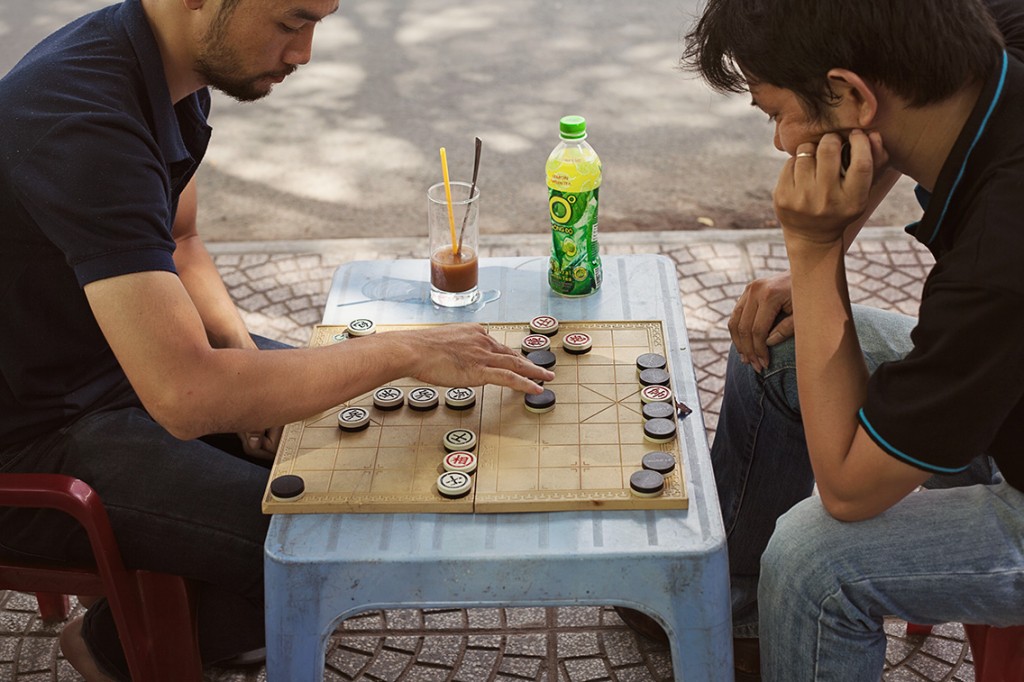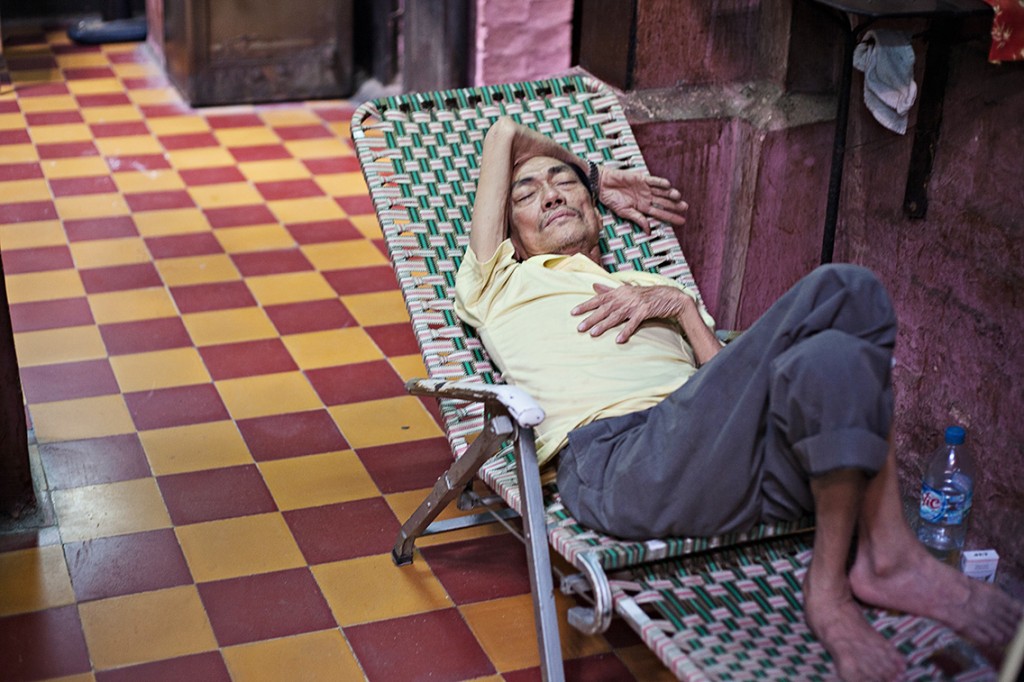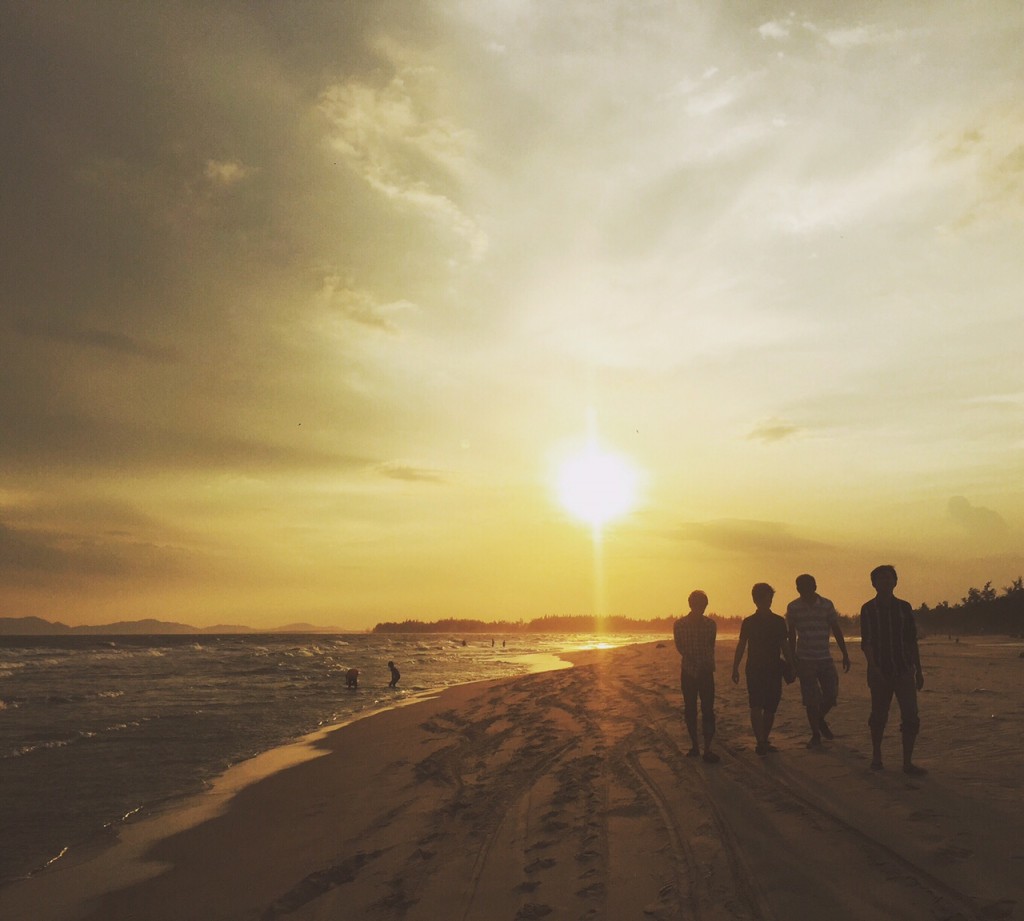Archive for 'Places'
The sound of crunching stones underfoot was almost deafening as we hiked up the steep gravel trail to the top of the peak, and onto the roof of Vietnam. Even in the cool northern air we were sweltering under the bright, dry sun. The stones were loose and unstable under our weary legs and before long we were stopping for a breath. I gulped down my water and repositioned my daypack as a breeze rushed past, giving us the energy needed for a final push to the top. With a sheer drop on our left side and solid Earth to our right we hugged the inside wall as we journeyed northward and ever deeper into the mountainous green landscape.
Ha Giang doesn’t so much scream for attention as it sits patiently, confident in the knowledge that its dramatic karst-ridden terrain will at first stun, and undoubtedly thrill any first time visitor to the region. Seated directly below China and reaching up as far north in the country as one can possibly travel, the vast majority of this province is made up of ethnic hill tribes, most notably the Hmong and Tay people. It feels like the edge of the world, or at least the country, and it is. It’s the end of the line, the last stop, and Vietnam’s farewell. There’s something wild and liberating about traveling to the end of a place, to its furthest extremities. Like a mountaineer reaching a summit and gazing out towards infinity, this borderland feels like Earth’s outer reaches.
Thousands of limestone peaks, known as Karsts, rise up from the ground at varying angles and sizes creating dense clusters of rocky, forested, lump shaped mountains. This unique topography, whilst beautiful, is not ideal land for agricultural activity and so the cultivation of rice and other crops is limited in this region. For all the limitations the geography does place on growing and harvesting, people still rely entirely on the land for their survival. The small valleys and slopes that are capable of being farmed are covered in cornfields and rice paddies. The locals carrying their harvests to and from the fields traverse the dirt tracks and pathways connecting one village to another. What little space is left for other crops become small allotments for sweet potatoes, leafy greens and cassava. At the local markets these crops are then sold or bartered for the rice that sustains life for so many.
On we trekked across a narrow mountain pass into a Hmong village set in the shadow of a particularly mammoth peak. Heading down the lone road towards the village were two young girls carrying large bundles of vegetation on their backs, their bright traditional attire making it arduously difficult for us to avert our eyes from the radiant pinks, greens and blues. As we walked past we smiled, and they shyly smiled back before they ascended the gently sloping hill and faded from view. We rounded a corner and came upon a group of modest homesteads set in the valley. The village was quiet with only the faint sounds of clucking chickens and women chattering. As we reached the end of the road we heard an excited “Nyob Zoo!” or “Hello!” in Hmong. Standing in front of an unassuming wooden house were a group of three women smiling and gesturing for us to approach. Their interest in me rivaled mine in them and as my guide fluently spoke the local dialect, we happily joined them on the porch for pleasantries. The eldest of the women was most curious. Eyeing me up and down as I stood reservedly in my t-shirt, mud-caked trousers and hiking boots, she smiled cheekily at what must have been a strange, unexpected and comically unsightly spectacle for a quiet Wednesday afternoon. She asked my guide about all of the particulars of my life and in between answers warmly looked towards me as an old friend would. There was a gentleness and openness in her expression that made me feel quite welcome, and with her permission I snapped a few photos.
After several minutes of warm conversation we carried on through that village and the next, with each passing village bringing more friendly smiles and exchanges as well as curious stares. Seeing the day-to-day of these hill tribes felt like a brief glimpse back to a way of life seemingly no longer in existence. Small children are seen out in the fields helping their mothers gather weeds as men ride past with baskets of piglets harnessed to their scooters. Young girls harvest the sweet potato fields with infant siblings strapped to their backs and elderly women weave hemp plants into textiles outside their homes. Groups of adolescents walk down the road rolling used bicycle tires with sticks as they keep an eye on their goat herds that graze the hillsides beside them. The scent of pine and burning corn stalks gives the air a woody alpine freshness not found in regions further south, and as the early evening sun dips below the peaks cooling the temperature considerably, one notices how incredibly hard life is up in these mountains. There’s a rawness and hardiness to the people as they live constantly on the brink of feast or famine, vulnerable to the fickleness of their natural surroundings and dependent entirely on their own industrious measures. But their distinctive cultures and time-honored customs continue to exist, and like the intricately woven patterns and motifs sewn into the fabric of their traditional dress, these varied and vibrant cultures add immense value to the diversity and magnetism of the country as a whole.
As nightfall loomed and the villagers retreated into their homes we hurriedly trekked back out of the valley and towards our pick up point nearer the road. Realizing that darkness now had the advantage, we quickened the pace and settled into a slow trot until we had reached the car. Driving along meandering roads perilously carved into the sides of the mountain and negotiating the famous Ma Pi Leng Pass was the setting for our final goodbye to the grandeur of this region. Staring out the open window at the silhouetted peaks, I thought about what I’d first heard of Ha Giang that made me want to visit. I’d listened to stories of its striking beauty, breathtaking roads and grand vistas, but it was the part about its wildness that had me captivated. The thought of exploring untamed pastures and the adventures they so often yield was what intrigued me most. In this regard I was certainly not disappointed, but where my expectations were vastly exceeded was the intimate way in which I experienced this wildness. The affectionate encounter I had with the women at their home and the warm smiles exchanged in the villages that I hiked through, that was the real adventure I was hoping for. The mountains and scenery were always a given but those momentary human connections were not. I sunk back into the passenger seat contentedly and mused over this for a while.
A few hours later we arrived at our homestay in a traditional bamboo stilt house, where we were treated to a generous supper of fried silk worms, spring rolls, sautéed pork, vegetables and lively conversation. Not long after the last scraps were devoured and the family had gone to sleep did I find myself lying cheerfully and haphazardly under a mosquito net, the abundant servings of rice wine having gone to my head. Despite the cloudiness, thoughts of the previous days events filled my mind and I soon began to wonder if I’d ever return to this memorable place, to this last wild frontier. Too exhausted to ponder the possibilities, but with a smile anchored to my weather worn face, I quickly drifted off to sleep in the cool and calm of the deep north.
For more images head here.
[Note: The thing about this particular piece is that despite the seemingly helpful sounding title, one really does not have to try very hard to get fat in Rome, nor does one need a guide in order to do it. Nor does one necessarily care to do it. Making this “How To” utterly useless in every way that a How to Guide is meant not to be. In fact, in not a single distinguishable way does this resemble a “How To” guide of any sort.]
——————————————
If one is not getting fat in Rome, then what may I ask is one doing?
Having been a resident of this fine city and a consumer of all of its consumables, I simply cannot think of how a person with a mouth in which to deposit food can spend anytime here at all and still have loose fitting trousers to show for it. If a person does happen to return home without so much as even a small amount of ‘derriere transformation’, I am lead to believe one of two things must have happened: 1) A 9.0 earthquake buried all food establishments under an endless heap of rubble. 2) Said person was stricken with an intestinal parasite aiding the fast and uncomfortable expulsion of calories.
It’s not that I particularly enjoy feeding myself to uncomfortable levels as some sort of sadistic culinary pastime; it’s just that when I’m in Rome, or anywhere in Italy for that matter, food finds me. I can only assume it finds us all. I am not so much a glutton as I am a victim, an innocent passerby who cannot outrun the speed at which the scent of parmiggiano travels. The olfactory force is too great. It’s a task too big for any one person to resist the hedonism that is three square meals of Buccatini all’ Amatriciana with a side of warm chocolate calzone. The streets of Rome are minefields of gastronomic temptations and I am one of their many casualties.
——————————————-
Let’s talk for a second about Italian social rituals.
First of all there’s the use of the hands. Their purpose goes far beyond conventional acts of holding cutlery and wiping one’s bum and Italians know this well. Whether flailing indiscriminately in disagreement or making demonstrative gestures near one’s groin area in order to communicate the “breaking of one’s balls,” Italians really take advantage of the human body’s upper extremities. They are as much a part of conversation as the words themselves and imagining Italians speaking without their hands is like trying to imagine American tourists without tube socks. The upper body’s full potential is really being met in Italy, and I think that’s something to consider for a moment.
Secondly, there’s directness. Having lived in Britain for the better part of the last decade and endured many a conversation containing more non-verbal proprieties and unwarranted expressions of apology than actual words themselves, I can tell you this: Bullshitting is hard work. It’s much more time effective, and at times life saving, to know out rightly if you’ve offended someone by adding milk to their tea before water or if your choice of shellfish starter is going to send your dinner guest into anaphylactic shock. Life is short, and if we make the grave mistake of leaving our thought reading devices at home then we’re all just wasting precious life moments imprisoned in an eternal loop of empty verbal gobbledygook. That or we’ve died a slow, suffocating death-by-crustacean. Italians do us all a great service when they get to the point bluntly and without hesitation. In this way, they are the most misunderstood of cultures. Famous for having no awareness of time or respect for punctuality, the opposite is actually true. They have a profound awareness of time. They know once they arrive to their scheduled social engagement they’ll already be saving you both 20 minutes by cutting the introductory bullshit and telling you that yes, your haircut does make you look like your mother. Knowing this, they leave 15 minutes later than you did. There’s no false complimenting or superficial douchebaggery once face-to-face and so based on this widely overlooked truth, Italians are actually always early. Italian tardiness is one of the most undeserved and ill informed stereotypes ever bestowed upon a country. And so, misunderstood and insulted, they carry on telling it like it is and saving us minutes of our lives by simply not beating around the bush, and we repay them by calling them lazy and late. The nerve.
——————————————
I’m usually not one for sweeping statements of grandeur and exaggerated claims without the support of hard hitting evidence-based research, well not this afternoon at least, but I believe the Italian meal might just be the most provocative act of social rebellion in today’s fractured world. It transcends the mere mechanical act of human nutritional consumption and approaches something much closer to the divine.
Modern society has taken the significance of food and the shared meal out of its cultural context and reduced it to a physiological juggling act of the digestive and posterior muscular systems. If we’re not chewing, swallowing and digesting our meals at the same time as walking, working or finishing some arbitrary chore, then we need to reevaluate our pointless and unproductive lives. Evolutionarily speaking, eating quickly on the run may have been a necessity for our primate ancestors when escaping danger or some Stone Age predatory threat. The only threat we’re faced with today is the decision to have the egg mayo baguette or the tuna club sandwich at the corner deli, so what’s the rush?
But Italians throw up a big middle finger to society’s devaluing of the meal. Don’t be preposterous they think. Food is to be made with the highest quality ingredients and eaten with gusto. Meals are to be seated affairs shared with other humans. Their indifference and utter disregard for any opposing school of thought on this is more than a simple difference of opinion, it’s revolutionary. It’s progressive. The table is more than a functional piece of furniture in Italy. It is the rebel force leader of a movement challenging all the modern ideas of progress. It is a four-legged symbol of resistance, of community, of our past but also hopefully our future, and of change in a disconnected and disoriented society. Long live the table! Viva la tavola!
—————————————-
Much like I believe the enduring significance of the meal in Italy presents an interesting discussion point for ideas of community mindedness and the values of slow living in the 21st century, at least for those of you who are miraculously still reading this; I too think the seemingly dull observations of a woman walking her dog around the lesser known Roman neighborhood of Piazza Bologna is a relevant topic for today’s garrulous ramblings about…. what is it we’re actually talking about again?
Having lived in the Piazza Bologna area as a young twenty-something student, my lengthy walk to school each morning was an interesting lesson on everyday Italian life in untouristed parts of the city. Hitting the streets was a way for me to experience the goings-on of daily Roman life in an intimate way and I reveled in the opportunity to integrate myself into the morning routines of the people around me.
There was one particular neighbor across the road sharing my same schedule and route down to the minute and street. Completely oblivious to my presence each morning, this woman exited her apartment with her Labrador in tow and headed off into the business of the morning. The first few days I found our corresponding routes uncanny, but of no particular interest as I trailed behind, neither outpacing nor falling behind her and the canine companion. But as the weeks progressed I began to notice the patterns in her morning routine as well as some of the deeper existential meanings behind the habits of this woman. In other jurisdictions this might have been considered suspicious behavior, illegal under some ordinance relating to “criminal stalking.” But as one who is still bearing the emotional scars of having once suffered a maniacal and unrelenting stalker, (it was a wildly predacious mosquito in the end but nonetheless a headache), I would have never engaged in such inappropriate absurdity. I was simply trying to lessen the monotony of a repetitious commute.
And so it went in all of those weeks and months of stalking, ehem, legally observing from an awkwardly short distance, that I picked up on a few recurring themes:
Not once, in more than 90 opportunities to do so if my calculations are correct, did this woman discard of her dog’s excrement. Not once. Instead she left steaming heaps of crap strewn across the pavement as if they were breadcrumbs helping guide her and Hansel back to their starting location in the magical forest. It was as if she believed her dog’s waste might actually be good for the concrete. But someone forgot to tell her that’s garden soil she’s thinking of, not paved pedestrian thoroughfares in urban centres. But still, her complete lack of interest and confident nonchalance in the whole idea made me laugh, and tread more carefully.
In every instance where a small injustice was taking place amongst locals and passersby, she addressed the issues she saw unashamedly by cursing so loudly and savagely that everyone in the vicinity tended to scatter for fear of their lives. One day it was a car driving too fast down a quiet residential road, another was a group of boisterous and unaware teenagers who almost took an elderly woman down with their rowdy curbside antics, another was a moving man carelessly teetering a sheet of plate glass on his head. Whatever and whomever it was committing these sins against society, she was right there with a cutting expletive followed by a lesson on life and proper behavior. Respect your elders! Drive slower! Watch what you’re doing! It didn’t matter the severity or triviality of the offensive act, she was there to uphold justice and she was going to do so using words you wouldn’t dream of saying in front of your mother. It was a riot and an absolute ball watching her passionate tirades as the defender against all evil in northwest Rome.
In between bouts of her gifting the city’s streets with tiny brown nuggets of feces and leaving Rome’s youth population with night terrors, I noticed a particular tendency she had when faced with an unexpected challenge. Whether inconveniently rerouted because of heavy construction work or bruised from a fall caused by her overly excitable Labrador tangling her up in its leash, or even after one of the aforementioned screaming matches with the neighborhood’s delinquents, she would pause for a moment, zip around to the nearest pastry establishment, tie the dog up outside and sit down to enjoy a baked good. It seemed every time something forced her to break routine she went off skulking across the road after some sugar coated comfort pastry. As if all the tensions of these unforeseen events needed to be settled within her and the only way was with the slow release of sugar into her bloodstream. It was odd, if not completely relatable. But it was also a perfectly delicious coping mechanism that I came to see as culturally relevant. And so, once again, Italy showed me how food and its ability to soothe and satisfy can have far reaching sociological effects that shape the very fabric and values of a country or society. Afterall, well-fed people are happy people.
—————————————–
In light of all these thought-provoking (and some overwhelmingly irrelevant and verbose) observations of Italian social customs, I’ve been adopting a more thoughtful approach to food, cutting the bullshit level down in my daily interactions, cursing at misbehaving adolescents I encounter, keeping my sense of humour when life’s shit gets dumped on the road before me, and eating pastries in the face of adversity ever since. Because la vita might not always be dolce, but a cannoli always is.
Over the last 5 months I’ve aimed to capture as much as possible of the diversity of people and places in Vietnam. It’s not nearly enough time to document the length and breadth of an entire country as teeming with culture and landscapes as Vietnam, but hopefully thus far I’ve captured at least a small fraction of its magnetism.
See the full gallery here.
A Hmong woman I met in a village just outside of Dong Van in Ha Giang province. She had no problem with my camera and just wanted to know as much about me as I did her.
For more images from my travels in the deep north of Vietnam head to the gallery: http://www.annieoswald.com/vietnam
People from the Mekong Delta are known in Vietnam as the friendliest anywhere in the country. Their reputation of being warm, generous and hospitable precedes them. I experienced no different in my time there.
Worshippers at the main sanctuary in the Jade Emperor Pagoda in Ho Chi Minh City. The statues in this temple are shrouded in a thick fog from the incense that burns around the clock and leaves a lingering scent of sandalwood and burning timber. It all adds to the sense of reverence and mystery as one enters the temple. Quiet and dark, one enters near a Chinese inscription that reads “The Light of Buddha Shines on All.”
Two men play Xiangqi, a traditional Chinese board game very popular here in Vietnam and in many places with large ethnic Chinese communities. Also known as “Chinese Chess.” You can’t walk around Saigon very long without seeing pairs of men playing this game out on the streets.
The beaches at sunset here are like family reunions everyday. Mothers, fathers, sisters, brothers, children and groups of friends together enjoying the last moments of light and washing away the day’s inequities with sea air and togetherness. A sense of community is woven into the very fiber of this place.

